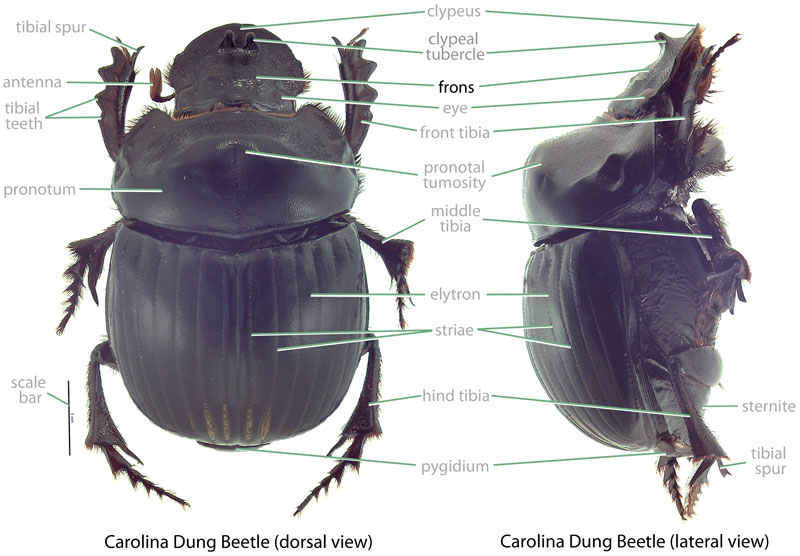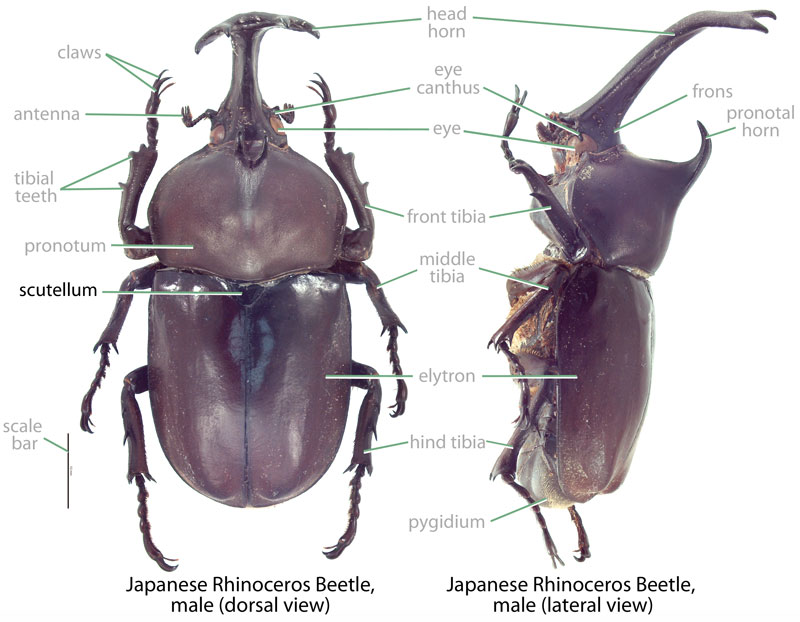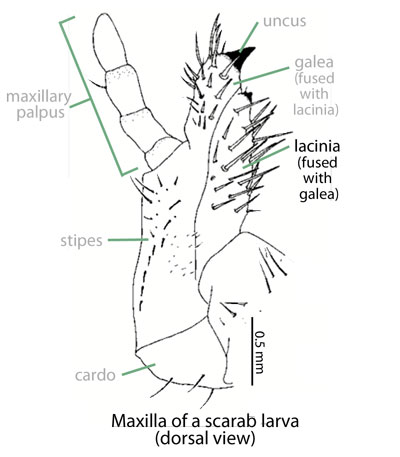Beneficial
Sri Lankan dung beetle, Sagittarius dung beetle
Family: Scarabaeidae Subfamily: Scarabaeinae Genus: Onthophagus Species: Onthophagus sagittarius (Fabricius, 1775)
DNA barcode available: specimen information
Total body length 10.0–13.0 mm (0.39–0.52 in). Body shape oval; may be caked in dung. Color dark brown; elytraelytra:
the hardened and chitinous wing-cover of a beetle that protect and overlie the flight wing
pale brown. Medium-sized Onthophagus, more than 10 mm. Clypealclypeal:
of, or referring to, the clypeus
apexapex:
point or edge furthest from the body
rounded to sinuatesinuate:
gently curved (specifically of margins or edges); often in reference to the clypeus
; not strongly produced or reflexedreflexed:
margin that curves upward
in either sex. Head of male with pairedpaired:
in relation to bilateral symmetry: occurring on both sides of the body
tusk-like horns on the clypeusclypeus:
part of the head anterior to the frons; the most anterior portion in dorsal view
 ; female with single horn on the fronsfrons:
; female with single horn on the fronsfrons:
part of the head generally positioned between the eyes (posterior to the clypeus and anterior to the vertex) and visible dorsally
 . Ocular canthuscanthus:
. Ocular canthuscanthus:
a process extending over and sometimes dividing the eye
not completely dividing eye. Pronotumpronotum:
the dorsal surface of the thorax
 with anterioranterior:
with anterioranterior:
the front or forward; opposite of posterior
angle rounded. Pronotumpronotum:
the dorsal surface of the thorax
 of male with broad, hump-like process; female with spine-like process. Front tibiatibia:
of male with broad, hump-like process; female with spine-like process. Front tibiatibia:
a segment of the leg articulated with the tarsus and femur
 of male and female similar. Scutellumscutellum:
of male and female similar. Scutellumscutellum:
the triangular portion of the thorax between the bases of the elytra
 absent.
absent.
Undescribed. For Onthophagus spp. (Ritcher, 1966Ritcher, 1966:
Ritcher P. 1966. White grubs and their allies: a study of North American scarabaeoid larvae. Oregon State University Monographs, Studies in Entomology 4: 1-219.): Grub C-shaped, hump-backed, cylindrical, and cream-colored. Maxillamaxilla:
set of paired mouthparts located posterior to the mandibles
with galeagalea:
outer branch or lobe of the maxilla
 and lacinialacinia:
and lacinialacinia:
inner portion of the maxilla distinctly separate. Epipharynxepipharynx:
distinctly separate. Epipharynxepipharynx:
lobe on the interior surface of the labrum or clypeus
with tormaetormae:
in scarab larvae, sclerotized structures on the ends of the clypeolateral suture extending towards the mesal line
united mesallymesally:
at or near midline of body
, anterioranterior:
the front or forward; opposite of posterior
phoba present. AntennaeAntennae:
paired sensory organ on head, formed from numerous segments
 4-segmented, distaldistal:
4-segmented, distaldistal:
situated away from the point of articulation, thus usually furthest from the body
segment much reduced. Legs 2-segmented. Prothoracic shieldprothoracic shield:
the chitinous plate behind the head of larvae
 without anteriorly projecting processes. Third abdominal segment bearing a prominent conical, dorsaldorsal:
without anteriorly projecting processes. Third abdominal segment bearing a prominent conical, dorsaldorsal:
of or relating to the upper surface; opposite of ventral
gibbosity covered with numerous short, stout setaesetae:
small, hair-like structure
.
Southeastern Asia. This species is native to southeastern Asia, where it has been recorded from Malaysia, Indochina (Hawaiian Entomological Society, 1964Hawaiian Entomological Society, 1964:
Anonymous. 1964. Notes and exhibitions. Proceedings of the Hawaiian Entomological Society 18: 344-347. full text (accessed 2015)), India (Chandra, 2000Chandra, 2000:
Chandra K. 2000. Inventory of scarabaeid beetles (Coleoptera) from Madhya Pradesh, India. Zoos' Print Journal 15: 359-362. full text (accessed 2015)), and Sri Lanka (Edwards, 2007Edwards, 2007:
Edwards P. 2007. Introduced dung beetles in Australia 1967-2007. Landcare Australia, Sydeny, New South Wales, Australia. full text (accessed 2015)). This species was introduced to Australia (Edwards, 2007Edwards, 2007:
Edwards P. 2007. Introduced dung beetles in Australia 1967-2007. Landcare Australia, Sydeny, New South Wales, Australia. full text (accessed 2015)).
None. This species feeds on dung as both an adult and larvalarva:
the immature form of an insect; in scarabs, also called grub or white grub; preceded by the egg stage, followed by the pupal stage
 . There are no records of this beetle feeding on live plant tissues.
. There are no records of this beetle feeding on live plant tissues.
Like related Onthophagus species, this nocturnal scarab is a dung tunneler, with the female creating a burrow under or near a fresh dung source (Simmons and Emlen, 2008Simmons and Emlen, 2008:
Simmons L and Emlen J. 2008. No fecundity cost of female secondary sexual trait expression in the horned beetle Onthophagus sagittarius . Journal of Evolutionary Biology 21: 1227-1235. DOI: 10.1111/j.1420-9101.2008.01575.x). The burrow is then provisioned with dung in the form of brood balls. Each ball is impregnated with an egg; larval development occurs within the brood ball. This species is confined to tropical areas that experience warm, wet summers, and annual rainfall over 800 mm (31.5 in) (Edwards, 2007Edwards, 2007:
Edwards P. 2007. Introduced dung beetles in Australia 1967-2007. Landcare Australia, Sydeny, New South Wales, Australia. full text (accessed 2015)).
None. This species recycles dung and is beneficial for ranching and farming in Hawaii. Primarily being a dung feeder, this species has never been recorded damaging crop or ornamental plants. Additionally, this scarab is not a threat to native dung beetles because none occur in Hawaii or Guam.
Established. There is conflicting information regarding the arrival of this species to Hawaii. Markin and Yoshioka (1998) reported that Onthophagus sagittarius was purposely released on Oahu in 1957 and 1958. However, Harris et al. (1982) stated that the species was accidentally introduced. Regardless, this scarab is now established on both Molokai and Oahu, where it is one of the most commonly encountered dung beetles (Nishida, 2002Nishida, 2002:
Nishida G (editor). 2002. Hawaiian terrestrial arthropod checklist, fourth edition. Bishop Museum Technical Report 22: 1-313.; Harris et al., 1982Harris et al., 1982:
Harris R, Onaga K, Blume R, Roth J, Summerlin J. 1982. Survey of beneficial insects in undisturbed cattle droppings on Oahu, Hawaii. Proceedings of the Hawaiian Entomological Society 24: 91-95.).
Not established or recorded. There are no records of this species from Guam.
In Hawaii, this species was probably intentionally imported.
This scarab could be confused with Onthophagus of similar color and medium size (more than 10 mm): Onthophagus nigriventris and Digitonthophagus gazella.
Major males of these species can quickly be distinguished by examination of the head armature (O. sagittarius with two tusk-like horns on the clypeusclypeus:
part of the head anterior to the frons; the most anterior portion in dorsal view
 versus O. nigriventris without horns or ridges, D. gazella with two short, upward curving horns at the base of the head).
versus O. nigriventris without horns or ridges, D. gazella with two short, upward curving horns at the base of the head).
Females and can be separated by examining the base of the head (O. sagittarius with a single horn O. nigriventris with a sinuatesinuate:
gently curved (specifically of margins or edges); often in reference to the clypeus
ridge, D. gazella with a straight, transversetransverse:
extending horizontally across a surface
ridge).
Onthophagus erectus Wiedemann, Onthophagus javanus Fabricius, Onthophagus obtusus Wiedemann, Onthophagus oryx Fabricius, Scarabaeus sagittarius Fabricius
Report your observation of this beneficial species at our iNaturalist project.